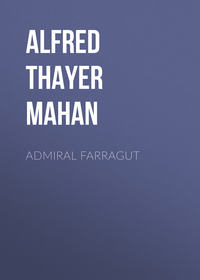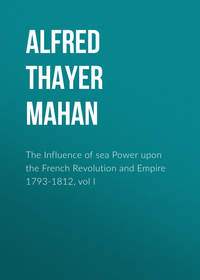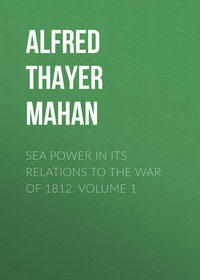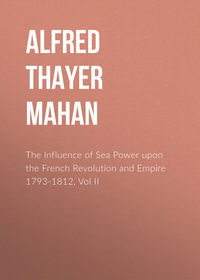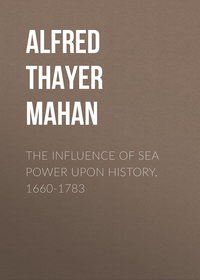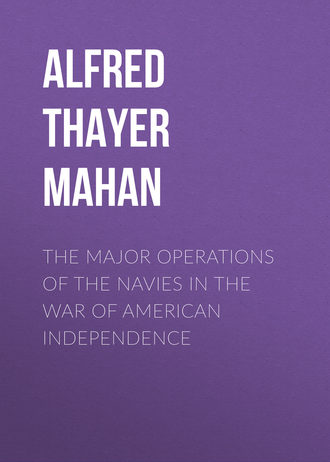 полная версия
полная версияThe Major Operations of the Navies in the War of American Independence
At the very moment of beginning his new policy, however, a subtle temptation assailed de Grasse irresistibly, in the exposed position of Hood's column (h); and he met it, not by a frank and hearty acceptance of a great opportunity, but by a half-measure. Hood thoroughly crushed, the British fleet became hopelessly inferior to the French; Hood damaged, and it became somewhat inferior: possibly it would be deterred from further pursuit. De Grasse decided for this second course, and ordered part of his fleet to attack. This operation was carried out under the orders of the Marquis de Vaudreuil, the second in command. The ships engaged in it bore down from the windward, attacked Hood's rear ships, stood along northward (f) on the weather side of his column at long range, and, having passed ahead, tacked (t) in succession and formed again in the rear, (f^2) whence they repeated the same manœuvre (Positions 1 and 2). Thus a procession of fifteen ships kept passing by eight, describing a continuous curve of elliptical form. They were able to do this because Hood was condemned to a low speed, lest he should draw too far away from the British centre (a) and rear (c), still becalmed under Dominica (Position 2). The French, having choice of distance, kept at long gunshot, because they were deficient in carronades, of which the British had many. These guns, of short range but large calibre, were thus rendered useless. Could they have come into play, the French rigging and sails would have suffered severely. This first engagement (Position 1) lasted, by Hood's log, from 9.48 to 10.25 A.M. It was resumed in stronger force (Position 2) at 14 minutes past noon, and continued till 1.45 P.M., when firing ceased for that day; Rodney hauling down the signal for battle at 2. Between the two affairs, which were identical in general character, Hood's column was reinforced, and great part of the British centre also got into action with some of the French main body, though at long range only. "Except the two rear ships," wrote Rodney to Hood that night, "the others fired at such a distance that I returned none."

Rodney and De Grasse, April 9 and 12, 1782
Figures 1 and 2
The injuries to the British ships engaged were not such as to compel them to leave the fleet. The Royal Oak lost her main topmast, and that of the Warrior fell two days later, not improbably from wounds; but in these was nothing that the ready hands of seamen could not repair so as to continue the chase. Rodney, therefore, contented himself with reversing the order of sailing, putting Hood in the rear, whereby he was able to refit, and yet follow fast enough not to be out of supporting distance. This circumstance caused Hood's division to be in the rear in the battle of the 12th. One of the French ships, the Caton, 64, had been so injured that de Grasse detached her into Guadeloupe. It must be remembered that a crippled ship in a chased fleet not only embarrasses movement, but may compromise the whole body, if the latter delay to protect it; whereas the chaser keeps between his lame birds and the enemy.
During the night of the 9th the British lay-to for repairs. The next morning they resumed the pursuit, turning to windward after the enemy, but upon the whole losing throughout the 10th and the 11th. At daylight of the 10th the French, by the logs of Hood and Cornwallis, were "from four to five leagues distant," "just in sight from the deck." During that night, however, the Zélé, 74, had collided with the Jason, 64; and the latter was injured so far as to be compelled to follow the Caton into Guadeloupe. At sunset of that day Rodney signalled a general chase to windward, the effect of which was to enable each ship to do her best according to her captain's judgment during the dark hours. Nevertheless, on the morning of the 11th the French seem again to have gained, for Hood, who, it will be remembered, was now in the rear, notes that at 10 A.M. twenty-two French sail (not all the fleet) could be counted from the masthead; Cornwallis, further to windward, could count thirty-three. Troude, a French authority, says that at that time nearly all the French had doubled The Saintes, that is, had got to windward of them, and it looked as though de Grasse might succeed in throwing off his pursuer. Unluckily, two ships, the Magnanime, 74, and the Zélé, 74, the latter of which had lost her main topmast, were several miles to leeward of the French main body. It was necessary to delay, or to drop those vessels. Again, trivial circumstances conspired to further a great disaster, and de Grasse bore down to cover the crippled ships; so losing much of his hard-won ground, and entailing a further misfortune that night. Rodney hung doggedly on, relying on the chapter of accidents, as one who knows that all things come to him who endures. To be sure, there was not much else he could do; yet he deserves credit for unremitting industry and pluck. During the afternoon, the signals noted in the British logs—to call in all cruisers and for the fleet to close—attest mutely the movement of de Grasse in bearing down,—coming nearer.
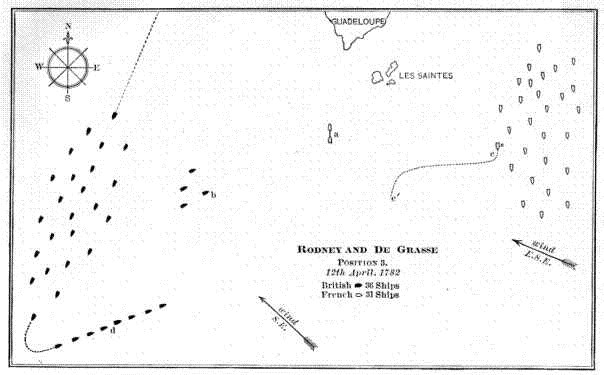
Rodney and De Grasse, April 9 and 12, 1782
Figure 3
During the night, at 2 A.M. of April 12th, the Zélé and de Grasse's flagship, the Ville de Paris, 110, crossing on opposite tacks, came into collision. The former lost both foremast and bowsprit. It has been stated by John Paul Jones, who by permission of Congress embarked a few months later on board the French fleet as a volunteer, and doubtless thus heard many personal narratives, that this accident was due to the deficiency of watch-officers in the French navy; the deck of the Zélé being in charge of a young ensign, instead of an experienced lieutenant. It was necessary to rid the fleet of the Zélé at once, or an action could not be avoided; so a frigate was summoned to tow her, and the two were left to make their way to Guadeloupe, while the others resumed the beat to windward. At 5 A.M. she and the frigate were again under way, steering for Guadeloupe, to the north-west, making from five to six miles (Position 3, a); but in the interval they had been nearly motionless, and consequently when day broke at 5.30 they were only two leagues from the Barfleur, Hood's flagship, which, still in the British rear, was then standing south on the port tack. The body of the French, (Position 3), was at about the same distance as on the previous evening,—ten to fifteen miles,—but the Ville de Paris (c) not more than eight. Just before 6 A.M. Rodney signalled Hood, who was nearest, to chase the Zélé; and four of the rearmost ships of the line were detached for that purpose (b). De Grasse, seeing this, signalled his vessels at 6 A.M. to close the flagship, making all sail; and he himself bore down to the westward (cc'), on the port tack, but running free, to frighten away Rodney's chasers. The British Admiral kept them out until 7 o'clock, by which time de Grasse was fairly committed to his false step. All cruisers were then called in, and the line was closed to one cable.114 Within an hour were heard the opening guns of the great battle, since known by the names of the 12th of April, or of The Saintes, and, in the French navy, of Dominica. The successive losses of the Caton, Jason, and Zélé, with the previous detachment of the two 50-gun ships with the convoy, had reduced the French numbers from thirty-five to thirty effective vessels. The thirty-six British remained undiminished.
The British appear to have been standing to the south on the port tack at daylight; but, soon after sending out the chasers, Rodney had ordered the line of bearing (from ship to ship) to be north-north-east to south-south-west, evidently in preparation for a close-hauled line of battle on the starboard tack, heading northerly to an east wind. Somewhat unusually, the wind that morning held at south-east for some time, enabling the British to lie up as high as east-north-east on the starboard tack (Position 3, d), on which they were when the battle joined; and this circumstance, being very favourable for gaining to windward,—to the eastward,—doubtless led to the annulling of the signal for the line of bearing, half an hour after it was made, and the substitution for it of the line of battle ahead at one cable. It is to be inferred that Rodney's first purpose was to tack together, thus restoring Hood to the van, his natural station; but the accident of the wind holding to the southward placed the actual van—regularly the rear—most to windward, and rendered it expedient to tack in succession, instead of all together, preserving to the full the opportunity which chance had extended for reaching the enemy. In the engagement, therefore, Hood commanded in the rear, and Rear-Admiral Drake in the van. The wind with the French seems to have been more to the eastward than with the British,—not an unusual circumstance in the neighbourhood of land.
As Rodney, notwithstanding his haste, had formed line from time to time during the past three days, his fleet was now in good order, and his signals were chiefly confined to keeping it closed. The French, on the other hand, were greatly scattered when their Commander-in-Chief, in an impulse of hasty, unbalanced judgment, abandoned his previous cautious policy and hurried them into action. Some of them were over ten miles to windward of the flagship. Though they crowded sail to rejoin her, there was not time enough for all to take their stations properly, between daylight and 8 A.M., when the firing began. "Our line of battle was formed under the fire of musketry,"115 wrote the Marquis de Vaudreuil, the second in command, who, being in the rear of the fleet on this occasion, and consequently among the last to be engaged, had excellent opportunity for observation. At the beginning it was in de Grasse's power to postpone action, until the order should be formed, by holding his wind under short canvas; while the mere sight of his vessels hurrying down for action would have compelled Rodney to call in the ships chasing the Zélé, the rescue of which was the sole motive of the French manœuvre. Instead of this, the French flagship kept off the wind; which precipitated the collision, while at the same time delaying the preparations needed to sustain it. To this de Grasse added another fault by forming on the port tack, the contrary to that on which the British were, and standing southerly towards Dominica. The effect of this was to bring his ships into the calms and baffling winds which cling to the shore-line, thus depriving them of their power of manœuvre. His object probably was to confine the engagement to a mere pass-by on opposite tacks, by which in all previous instances the French had thwarted the decisive action that Rodney sought. Nevertheless, the blunder was evident at once to French eyes. "What evil genius has inspired the admiral?" exclaimed du Pavillon, Vaudreuil's flag-captain, who was esteemed one of the best tacticians in France, and who fell in the battle.
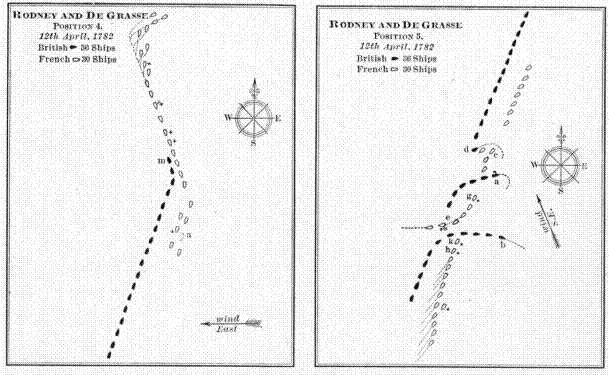
Rodney and De Grasse, April 9 and 12, 1782
Figures 4 and 5
As the two lines drew near to one another, standing, the French south, the British east-north-east, the wind shifted back to the eastward, allowing the French to head higher, to south-south-east, and knocking the British off to north-north-east (Position 4). The head of the French column thus passed out of gunshot, across the bows of Rodney's leading vessel, the Marlborough, (m), which came within range when abreast the eighth ship. The first shots were fired by the Brave, 74, ninth in the French line, at 8 A.M. The British captain then put his helm up and ran slowly along, north-north-west, under the lee of the French, towards their rear. The rest of the British fleet followed in his wake. The battle thus assumed the form of passing in opposite directions on parallel lines; except that the French ships, as they successively cleared the point where the British column struck their line, would draw out of fire, their course diverging thenceforth from that of the British approach. The effect of this would be that the British rear, when it reached that point, would be fresh, having undergone no fire, and with that advantage would encounter the French rear, which had received already the fire of the British van and centre. To obviate this, by bringing his own van into action, de Grasse signalled the van ships to lead south-south-west, parallel with the British north-north-east (4, a). The engagement thus became general all along the lines; but it is probable that the French van was never well formed. Its commander, at all events, reached his post later than the commander of the rear did his.116
At five minutes past eight, Rodney made a general signal for close action, followed immediately by another for the leading ships to head one point to starboard—towards the enemy—which indicates that he was not satisfied with the distance first taken by the Marlborough. The Formidable, his flagship, eighteenth in the column, began to fire at 8.23;117 but the Barfleur, Hood's flagship, which was thirty-first, not till 9.25. This difference in time is to be accounted for chiefly by the light airs near Dominica, contrasted with the fresh trades in the open channel to the northward, which the leading British vessels felt before their rear. De Grasse now, too late, had realised the disastrous effect which this would have upon his fleet. If he escaped all else, his ships, baffled by calms and catspaws while the British had a breeze, must lose the weather-gage, and with it the hope of evading pursuit, hitherto his chief preoccupation. Twice he signalled to wear,—first, all together, then in succession,—but, although the signals were seen, they could not be obeyed with the enemy close under the lee. "The French fleet," comments Chevalier justly, "had freedom of movement no longer. A fleet cannot wear with an enemy's fleet within musket-range to leeward."
The movement therefore continued as described, the opposing ships slowly "sliding by" each other until about 9.15, when the wind suddenly shifted back to south-east again. The necessity of keeping the sails full forced the bows of each French vessel towards the enemy (Position 5), destroying the order in column, and throwing the fleet into échelon, or, as the phrase then was, into bow and quarter line.118 The British, on the contrary, were free either to hold their course or to head towards the enemy. Rodney's flagship (5, a) luffed, and led through the French line just astern of the Glorieux, 74, (g), which was the nineteenth in their order. She was followed by five ships; and her next ahead also, the Duke (d), seeing her chief's movement, imitated it, breaking through the line astern of the twenty-third French. The Glorieux, on the starboard hand of Rodney's little column, received its successive broadsides. Her main and mizzen masts went overboard at 9.28, when the Canada, third astern of the Formidable, had just passed her; and a few moments later her foremast and bowsprit fell. At 9.33 the Canada was to windward of the French line. The flagship Formidable was using both broadsides as she broke through the enemy's order. On her port hand, between her and the Duke, were four French ships huddled together (c), one of which had paid off the wrong way; that is, after the shift of wind took her aback, her sails had filled on the opposite tack from that of the rest of her fleet.119 These four, receiving the repeated broadsides, at close quarters, of the Formidable, Duke, and Namur, and having undergone besides the fire of the British van, were very severely mauled. While these things were happening, the Bedford, the sixth astern of the Formidable, perhaps unable to see her next ahead in the smoke, had luffed independently (b), and was followed by the twelve rearmost British ships, whom she led through the French order astern of the César, 74, (k), twelfth from the van. This ship and her next ahead, the Hector, 74, (h), suffered as did the Glorieux. The Barfleur, which was in the centre of this column of thirteen, opened fire at 9.25. At 10.45 she "ceased firing, having passed the enemy's van ships;" that is, she was well on the weather side of the French fleet. Some of the rearmost of Hood's division, however, were still engaged at noon; but probably all were then to windward of the enemy.
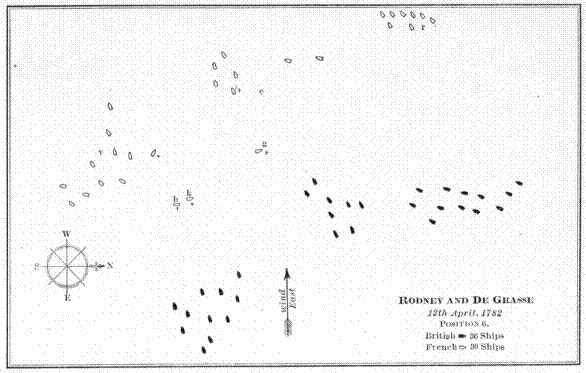
Rodney and De Grasse, April 9 and 12, 1782
Figure 6
The British ships ahead of the Duke, the van and part of the centre, in all sixteen sail, had continued to stand to the northward. At the time Rodney broke the line, several of them must have passed beyond the French rear, and out of action. One, the America, the twelfth from the van, wore without signals, to pursue the enemy, and her example was followed at once by the ship next ahead, the Russell, Captain Saumarez. No signal following, the America again wore and followed her leaders, but the Russell continued as she was, now to windward of the French; by which course she was able to take a conspicuous share in the closing scenes. At 11.33 Rodney signalled the van to tack, but the delay of an hour or more had given the Russell a start over the other ships of her division "towards the enemy" which could not be overcome.
The effect of these several occurrences had been to transfer the weather-gage, the position for attack, to the British from the French, and to divide the latter also into three groups, widely separated and disordered (Position 6). In the centre was the flagship Ville de Paris with five ships (c). To windward of her, and two miles distant, was the van, of some dozen vessels (v). The rear was four miles away to leeward (r). To restore the order, and to connect the fleet again, it was decided to re-form on the leewardmost ships; and several signals to this effect were made by de Grasse. They received but imperfect execution. The manageable vessels succeeded easily enough in running before the wind to leeward, but, when there, exactitude of position and of movement was unattainable to ships in various degrees of disability, with light and baffling side airs. The French were never again in order after the wind shifted and the line was broken; but the movement to leeward left the dismasted Glorieux, (g), Hector, (h), and César, (k), motionless between the hostile lines.
It has been remarked, disparagingly, that the British fleet also was divided into three by the manœuvre of breaking the line. This is true; but the advantage remained with it incontestably, in two respects. By favor of the wind, each of the three groups had been able to maintain its general formation in line or column, instead of being thrown entirely out, as the French were; and passing thus in column along the Glorieux, Hector, and César, they wrought upon these three ships a concentration of injury which had no parallel among the British vessels. The French in fact had lost three ships, as well as the wind. To these certain disadvantages is probably to be added a demoralisation among the French crews, from the much heavier losses resultant upon the British practice of firing at the hull. An officer present in the action told Sir John Ross120 afterwards that the French fired very high throughout; and he cited in illustration that the three trucks121 of the British Princesa were shot away. Sir Gilbert Blane, who, though Physician to the Fleet, obtained permission to be on deck throughout the action, wrote ten days after it, "I can aver from my own observation that the French fire slackens as we approach, and is totally silent when we are close alongside." It is needless to say that a marked superiority of fire will silence that of the bravest enemy; and the practice of aiming at the spars and sails, however suited for frustrating an approach, substantially conceded that superiority upon which the issue of decisive battle depends. As illustrative of this result, the British loss will be stated here. It was but 243 killed and 816 wounded in a fleet of thirty-six sail. The highest in any one ship was that of the Duke, 73 killed and wounded. No certain account, or even very probable estimate, of the French loss has ever been given. None is cited by French authorities. Sir Gilbert Blane, who was favourably placed for information, reckoned that of the Ville de Paris alone to be 300. There being fifty-four hundred troops distributed among the vessels of the fleet, the casualties would be proportionately more numerous; but, even allowing for this, there can be no doubt that the loss of the French, to use Chevalier's words, "was certainly much more considerable" than that reported by the British. Six post-captains out of thirty were killed, against two British out of thirty-six.
Rodney did not make adequate use of the great opportunity, which accident rather than design had given him at noon of April 12th. He did allow a certain liberty of manœuvre, by discontinuing the order for the line of battle; but the signal for close action, hoisted at 1 P.M., was hauled down a half-hour later. Hood, who realised the conditions plainly visible, as well as the reasonable inferences therefrom, wished the order given for a general chase, which would have applied the spur of emulation to every captain present, without surrendering the hold that particular signals afford upon indiscreet movements. He bitterly censured the Admiral's failure to issue this command. Had it been done, he said:—
"I am very confident we should have had twenty sail of the enemy's ships before dark. Instead of that, he pursued only under his topsails (sometimes his foresail was set and at others his mizzen topsail aback) the greatest part of the afternoon, though the flying enemy had all the sail set their very shattered state would allow."122
To make signal for a general chase was beyond the competence of a junior admiral; but Hood did what he could, by repeated signals to individual ships of his own division to make more sail, by setting all he could on the Barfleur, and by getting out his boats to tow her head round. Sir Gilbert Blane unintentionally gives a similar impression of laxity.
"After cutting the French line, the action during the rest of the day was partial and desultory, the enemy never being able to form, and several of the [our] ships being obliged to lie by and repair their damages. As the signal for the line was now hauled down, every ship annoyed the enemy as their respective commanders judged best."123
For this indolent abandonment of the captains to their own devices, the correctest remedy was, as Hood indicated, the order for a general chase, supplemented by a watchful supervision, which should check the over-rash and stimulate the over-cautious. If Hood's account of the sail carried by Rodney be correct, the Commander-in-Chief did not even set the best example. In this languid pursuit, the three crippled French ships were overhauled, and of course had to strike; and a fourth, the Ardent, 64, was taken, owing to her indifferent sailing. Towards sunset the flagship Ville de Paris, 110,124 the finest ship of war afloat, having been valiantly defended against a host of enemies throughout great part of the afternoon, and having expended all her ammunition, hauled down her colours. The two British vessels then immediately engaged with her were the Russell and the Barfleur, Hood's flagship, to the latter of which she formally surrendered; the exact moment, noted in Hood's journal, being 6.29 P.M.
At 6.45 Rodney made the signal for the fleet to bring-to (form line and stop) on the port tack, and he remained lying-to during the night, while the French continued to retreat under the orders of the Marquis de Vaudreuil, who by de Grasse's capture had become commander-in-chief. For this easy-going deliberation also Hood had strong words of condemnation.





